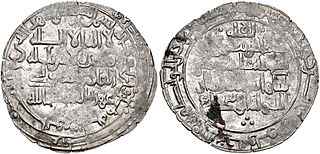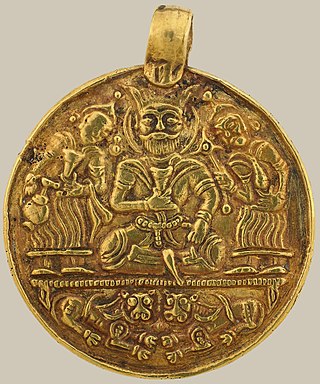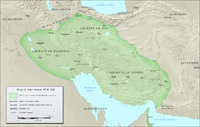Related Research Articles

The Buyid dynasty, also spelled Buwayhid, was a Zaydi and, later, Twelver Shia dynasty of Daylamite origin, which mainly ruled over central and southern Iran and Iraq from 934 to 1062. Coupled with the rise of other Iranian dynasties in the region, the approximate century of Buyid rule represents the period in Iranian history sometimes called the "Iranian Intermezzo".

The Ziyarid dynasty was an Iranian dynasty of Gilaki origin that ruled Tabaristan from 931 to 1090 during the Iranian Intermezzo period. The empire rose to prominence during the leadership of Mardavij. After his death, his brother Vushmgir and his Samanid allies led the dynasty in wrestling for control over territory against the Buyids in the early- to mid-10th century. When Vushmgir died, his sons Bisutun and Qabus fought for influence. Qabus would eventually outlive his brother and ruled the kingdom. However, Qabus was placed in exile from 980 to 998 by the Buyid ruler, Adud al-Dawla who would then dominate Tabaristan, the heartland of Ziyarid power. A succession of other rulers came to rule the kingdom with Ghaznavid support in the early 11th century. The Nizari Ismaili state invaded and ended Ziyarid rule in 1090.
Sayyida Shirin, also simply known as Sayyida (سیدا), was a Bavandid princess, who was the wife of the Buyid amir (ruler) Fakhr al-Dawla.

Abu Kalijar Marzuban was the Buyid amir of Fars (1024–1048), Kerman (1028–1048) and Iraq (1044–1048). He was the eldest son of Sultan al-Dawla.

Abu Shuja, better known by his laqab of Sultan al-Dawla, was the Buyid amir of Fars (1012–1024) and Iraq (1012–1021). He was the son of Baha' al-Dawla.

Abu Nasr Firuz Kharshadh, better known by his laqab of Baha al-Dawla was the Buyid amir of Iraq (988–1012), along with Fars and Kerman (998–1012). His early reign was dominated by struggles with his rival relatives over control of the western Persian provinces, but by 998 he managed to establish his supremacy over the Buyid confederation. His reign nevertheless saw the increasing encroachment of neighbouring powers on Buyid territory, and marks the beginning of the decline of the Buyids' power. He was the third son of 'Adud al-Dawla.
Abu'l-Fawaris, better known by his regnal name Qawam al-Dawla, was the Buyid ruler of Kerman (1012–1028). He was the son of Baha' al-Dawla.

Abu Taher, better known by his regnal name Shams Al-Dawla, was the Buyid ruler of Hamadan from 997 to 1021. He was the son of Fakhr al-Dawla.
Abu'l-Hasan Ali ibn al-Hasan, better known by his laqab of Fakhr al-Dawla was the Buyid amir of Jibal, Hamadan (984–997) and Gurgan and Tabaristan (984–997). He was the second son of Rukn al-Dawla.

Hasan, better known by his laqab as Rukn al-Dawla, was the first Buyid amir of northern and central Iran. He was the son of Buya.

Abu Mansur Buya, better known by his honorific title of Mu'ayyad al-Dawla was the Buyid amir of Hamadan (976–983), Jibal (977–983), Tabaristan (980–983), and Gorgan (981–983). He was the third son of Rukn al-Dawla.

Abu Talib Rustam, commonly known by his laqab of Majd al-Dawla, was the last amir (ruler) of the Buyid amirate of Ray from 997 to 1029. He was the eldest son of Fakhr al-Dawla. A weak ruler, he was a figurehead most of his reign, whilst his mother Sayyida Shirin was the real ruler of the kingdom.

The Kakuyids were a Shia Muslim dynasty of Daylamite origin that held power in western Persia, Jibal and Kurdistan. They later became atabegs (governors) of Yazd, Isfahan and Abarkuh from c. 1051 to 1141. They were related to the Buyids.

Fannā (Panāh) Khusraw, better known by his laqab of ʿAḍud al-Dawla was an emir of the Buyid dynasty, ruling from 949 to 983, and at his height of power ruling an empire stretching from Makran to Yemen and the shores of the Mediterranean Sea. He is widely regarded as the greatest monarch of the dynasty, and by the end of his reign he was the most powerful ruler in the Middle East.
Abu 'l-Fadl Muhammad ibn Abi Abdallah al-Husayn ibn Muhammad al-Katib, commonly known after his father as Ibn al-'Amid was a Persian statesman who served as the vizier of the Buyid ruler Rukn al-Dawla for thirty years, from 940 until his death in 970. His son, Abu'l-Fath Ali ibn Muhammad, also called Ibn al-'Amid, succeeded him in his office.

Muhammad ibn Rustam Dushmanziyar, also known by his laqab of Ala al-Dawla Muhammad, was a Daylamite military commander who founded in 1008 the short-lived but important independent Kakuyid dynasty in Jibal. He is also known as Pusar-i Kaku, Ibn Kakuyeh, Ibn Kakuya, and Ibn Kaku, which means maternal uncle in the Deylami language, and is related to the Persian word "kaka". Muhammad died in September 1041 after having carved out a powerful kingdom which included western Persia and Jibal. However, these gains were quickly lost under his successors.
Shahriyar II was the eleventh ruler of the Bavand dynasty from 930 to 964. He was the son and successor of Sharwin II.

Abu Ja'far Muhammad, was the ruler of the Bavand dynasty from an unknown date until his capture and defeat by the Kakuyids in 1027.
Hasanwayh, also known as Abu'l-Fawaris, was the Kurdish founder of the Hasanwayhid dynasty, ruling from 961 to 979.

Badr ibn Hasanwayh was the second ruler of the Hasanwayhids from 979 to 1014. He was the son and successor of Hasanwayh.
References
- Bosworth, C. E. (1975). "Iran under the Būyids". In Frye, Richard N. (ed.). The Cambridge History of Iran, Volume 4: From the Arab Invasion to the Saljuqs. Cambridge: Cambridge University Press. pp. 250–305. ISBN 0-521-20093-8.
- Nagel, Tilman (1990). "BUYIDS". In Yarshater, Ehsan (ed.). Encyclopædia Iranica, Volume IV/6: Burial II–Calendars II. London and New York: Routledge & Kegan Paul. pp. 578–586. ISBN 978-0-71009-129-1.
